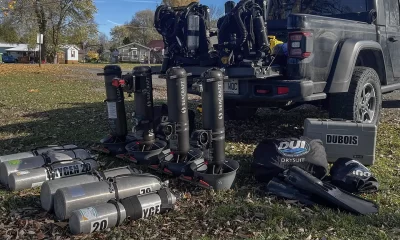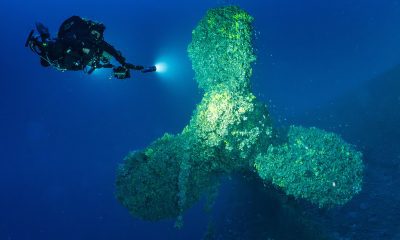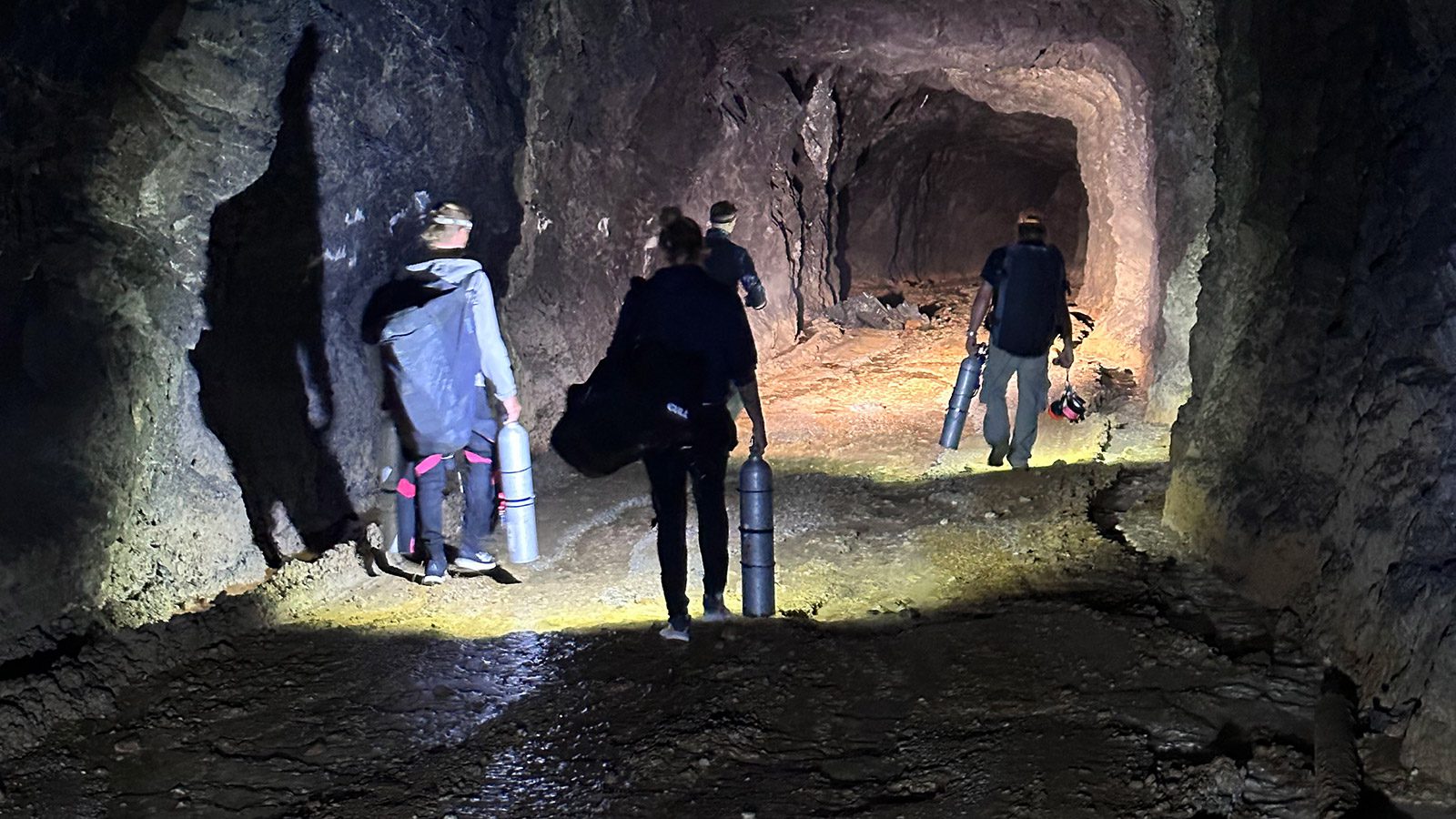
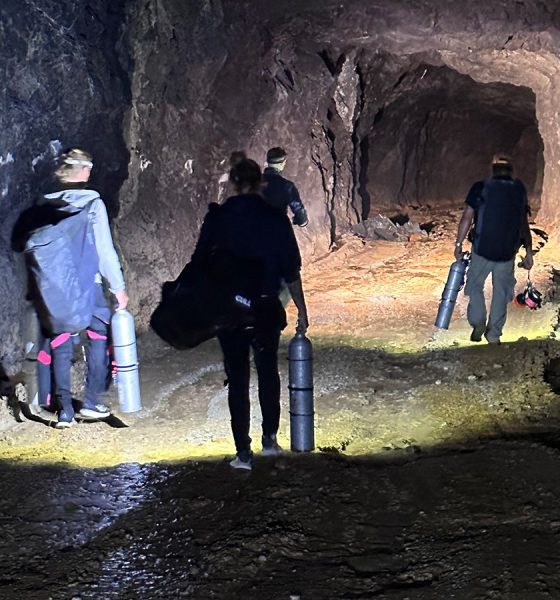
Cave
A First Exploration of the Flooded Mines of Thailand
Thailand-based, Finnish explorer Mikko Paasi reports on the first known exploration of the Sahakorn Nikon mine, which he and his team recently conducted in late 2022. Located in the Kanchanaburi province in northwest Thailand, the mine complex, which was abandoned and flooded some thirty years ago, is believed to be the largest in Asia. Working with local authorities, the team is planning to conduct a 3D photogrammetry survey of the complex, which lacks maps or blueprints. Paasi, who was recognized by the King of Thailand, and president of Finland for his efforts in the Thai cave rescue, believes the discovery heralds a new era of local exploration.
By Mikko Paasi. Header image: Bottomline Projects exploration team ”The Filthy Few” descending to the Song Toh mine in Kanchanaburi province to conduct the first ever mine dive in Thailand. Photo: Karn Romyasai
I’ve always been passionate about mine diving. Actually I started my professional dive career in Ojamo mine in 1998, which is where I went through a year long instructor training. During that year, we conducted nearly 300 dives in the mine. Back in the 90s there was no proper training available, so we poked our heads around the first chambers with our c- battery-loaded 100 lumen bulb lights.
Today, with all the developing technology in the diving industry, overhead environment diving has developed to a totally new level. DPV’s, rebreathers, and powerful handheld torches help us penetrate further than we could have even dreamed a few decades ago. Even if mine diving might be popular in Europe, in Thailand it is a totally new privilege, and according to my knowledge, no one had dived here before until a couple of years ago, when we decided to start scouting old, flooded and abandoned mine sites.
Like many exploration projects, this one started a long time ago over a pint of beer and a drawing board. After a long while scouting around, we finally began to locate serious mine options that were worth checking out. This is a story of the first two flooded mines that we discovered and dived in Thailand.
Into the Mines of Moria, err Thailand
Thailand has a rich mining culture. The main minerals have been lead, tin, zinc, gold, and other heavy metals. Our first exploration target, the Sahakorn Nikon mine, is located in Kanchanaburi province near the Mayanmar border in northwest region of Thailand. It is believed to be the largest mine complex in Asia. For three generations and about a hundred years the Bhol family extracted lead minerals from under the stone mountain the locals call the “Everest of Thailand” for the shape of it. The mining stopped here over 30 years ago and the underground section has been submersed ever since.
Our dive team is based on a small island in the middle of the Gulf of Thailand, called Koh Tao, where I have been running my dive center for the past 25 years. Koh Tao Divers (KTD) is where we train our Bottomline Projects foundation team and other like-minded divers. I was the expedition leader and the rest of our dive team consisted of two full cave and KISS Sidewinder rebreather divers, Naomi Allen and Pasi Laihanen, a couple who both work as instructors at KTD.
To get to the mine area we first needed to load up all our gear into a high speed catamaran that took us to the mainland where a minivan took us on the second leg of the journey, a 800 kilometer drive up north. On the way, we picked up two dry cavers, David Templeman and Karn Romyasai, who had been in these mines before and knew the coordinates and the location of the possible diving spots inside the mines.
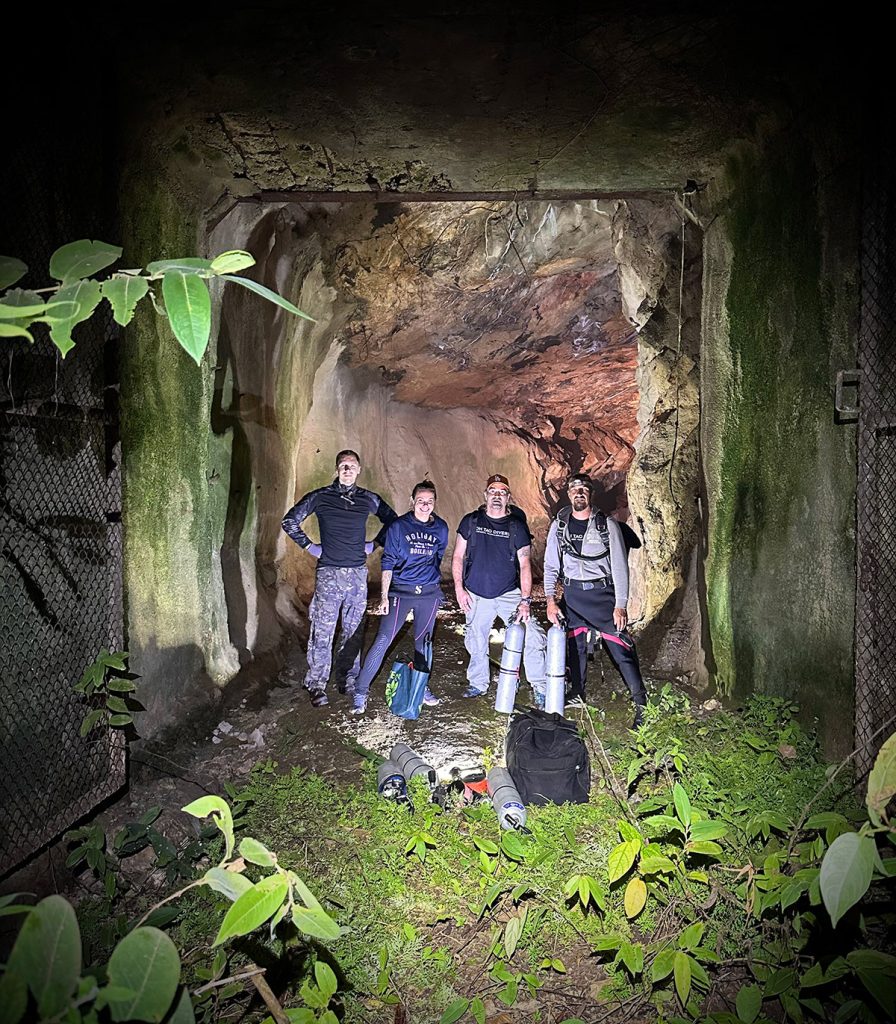
We arrived on the site around 04:00 AM in the heart of the night. This area is known for its herd of wild elephants that kill many members of the local community every year. Cutting away the jungle with our machetes in the dark, pushing our way toward the hidden entrance, we made ourselves very vulnerable to the wild life surrounding us.
Eventually, after a downhill journey of a half kilometer transporting our equipment through the slippery terrain, we found the entrance and started to descend down a spiraling drive way that led us to the water. Once we arrived at the water level, we realized that the mine was a monster, both in size and the hostile conditions such as quicksand that could suck you down to your hips, mud, and rusty, fragile structures to be navigated. We couldn’t help imagining how it would be under the surface..
Encouraged by the fact that we had come all the way here and that we were actually about to do the first mine dive in the Kingdom, we began our way toward the shaft that led down to what was unknown to us. My tool for the job was a mechanical ccr, KISS Sidewinder with two aluminum 40 cf bailouts side-mounted on both sides, my colleagues, Pasi and Naomi, were both on open circuit sidemount. While gearing up, I had torn my drysuit wrist seal completely off, and since I didn’t have a spare with me, I had zip-tied my right sleeve to minimize the leak. Luckily, the water was 20ºC/68ºF.
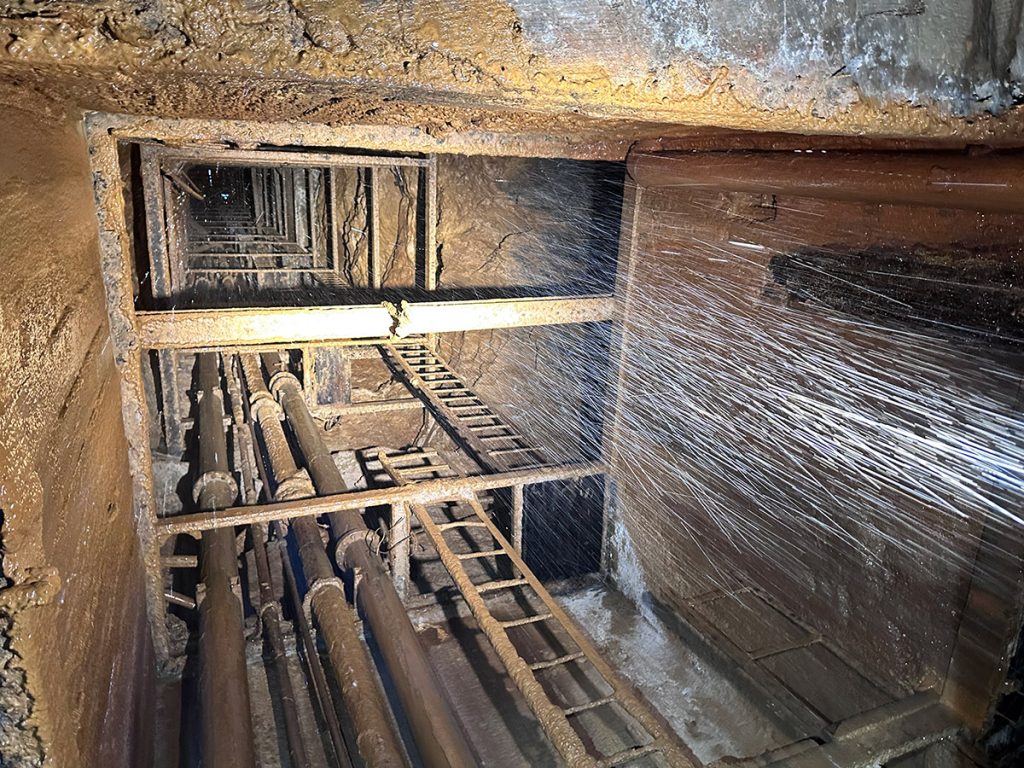
Since these mines do not have maps or blueprints that would have given us some idea of what was waiting for us down there. By the time I got my reel line attached to the super structure, the visibility at the shaft had dropped from five meters to zero. We started our dive by dropping down and feeling our way in until we reached the first tunnel at just 10 m/33 ft depth. Everything was covered with a thick layer of fine dust, and we were lucky to manage a few tie offs on the way until we popped into another vertical shaft with massive amounts of plumbing and rusty ladders going in multiple directions. We had just traversed to another vent shaft that led straight away to the ground surface and had exited the mine about 50 m/164 ft above us. Unfortunately, when calculating the risk versus the reward, this experience was not worth risking any more exploring with the given equipment and gasses we had with us. Yet again, we think the shafts will keep going and, given the amount of structure there was, it must go for quite some way.
At sunrise we surfaced back to the ground level and out from the darkness of this monster of a mine. The next site was approximately a two-hour drive away. We had time for some breakfast and to focus on the next dive in another abandoned, flooded mine.

At 11:00 am we arrived, and the approach was a bit easier since we had the daylight with us. Once we found the entrance, we started walking in, following David, who was leading us to the spot where the tunnel submerged. Our hopes were realistic, because we had just dived a massive and fairly potential mine a couple of hours before. We knew that the main tunnel where we were now walking on the ground level was over two kilometers long, and we couldn’t help thinking about what could lie underneath our feet.
At the water’s edge we started to get excited. The color of the water and the surroundings reminded us of the Mexican cenotes, except these tunnels were man-made ”rusty caves” with all sorts of machinery in them.
We slid in, tied off to a pipe that led down, and off we went. The walls were bright and everything was covered with fine white silt that settled down shortly. Visibility exceeded our expectations, being between 10-20 m/33-66 ft from time to time. This tunnel was shallow, just barely under water, and after a few junctions and turns, we popped up in a big chamber with daylight shining in. We’d just discovered an alternative entry/exit to the mine and accidentally traversed into it. We ended our first reel there and tied it on permanently to a plumbing pipe.
We took a quick look around the chamber and noticed that opposite to where the day light was coming there was a massive driveway with multiple pipes leading deeper down toward the heart of the mountain. The visibility was crystal clear, and the main tunnel had constant junctions and dead ends to the left and the right. We knew we had struck gold and would be back again soon with a bit more gear and a clearer idea of what we were up against.
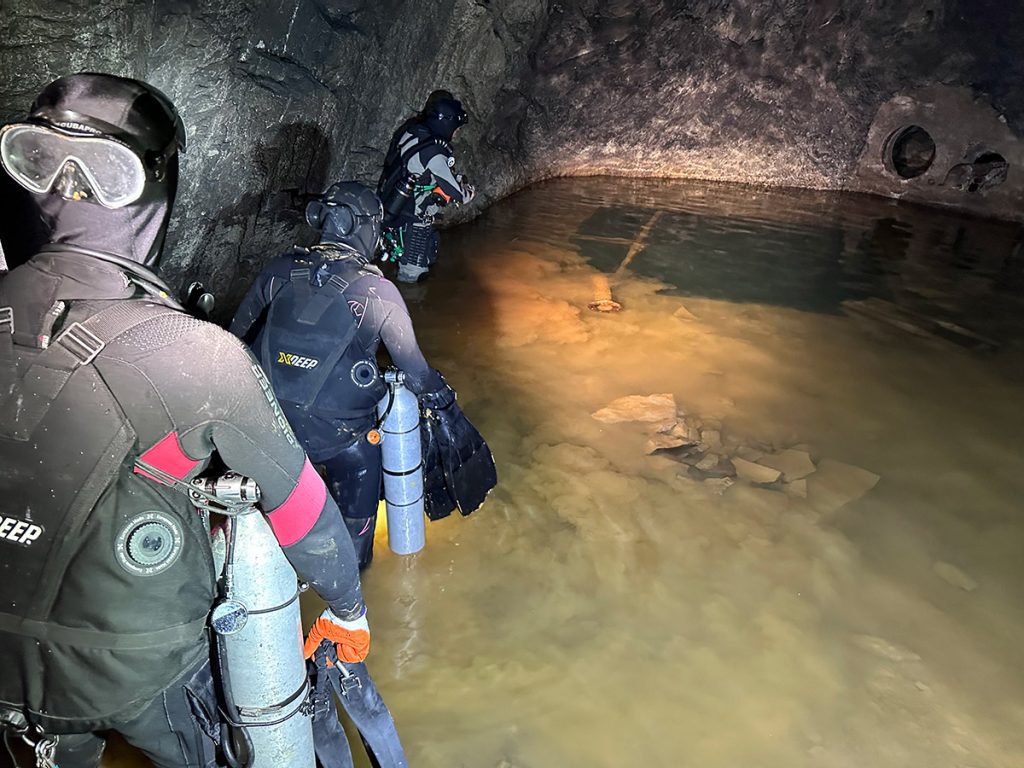
Our Second Push
Back on our little island, we had time to get prepared for the second push into the mines but with out-dated information. At least we had a family contact when we needed to get permission for further exploration. We had also decided to concentrate on only the second mine since we felt it was well worth the risk. From the first trip, we had many questions:, will the tunnel extend, or will it pop back to the surface? Are there other, deeper levels under the first one? Is the water quality safe to dive in? How big is the complex down there?
The second push dive team consisted of two of my friends, Cedric and Fan, who were both full mine CCR divers and top-notch blokes with which to hang around.
This time we arrived at 03:30 AM after a boat ride and a night in the van. We immediately went scouting and carried the first load of equipment to the starting point. During the three hours of scouting around the dry mine tunnels we found two new entry points which then made four different entries to the underworld. Would they all be connected?
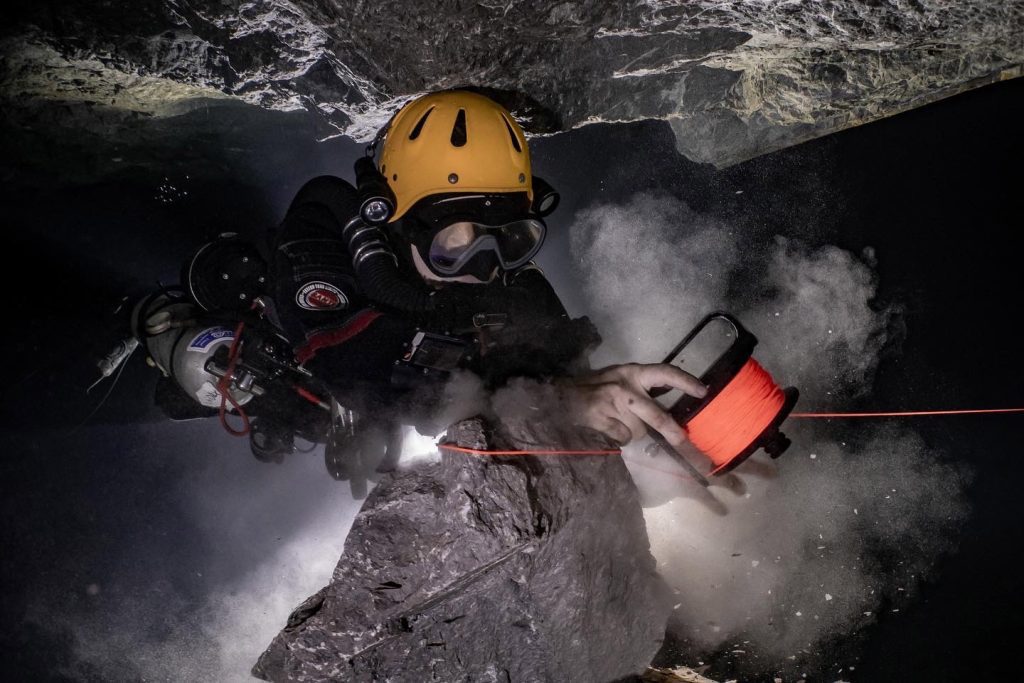
With the sunrise on our backs, we entered the mine and began to prepare for the first push dive. This time, we had brought with us a kilometer of cave line and we were vigorously spooling it into our reels while keeping an eye out for the scorpions, snakes, and other critters that might be crawling into our Sidewinders mouth pieces. The first question was, would the main tunnel, the one that we found the last time, surface or would it go deeper. Tying off to the piping on the sides was easy, and we soon figured that we would have work to do for years in this place. There were constant crossroads, and the driveway kept going on, deeper and straight into the mountain.
We emptied our reels and turned the dive. The scenery, while diving back, and watching Cedric and Fan gliding in the distance, was breathtaking and I could tell what they were feeling at that moment, knowing that when you’ve just discovered something enormous, your mind races with so many possibilities.

This time we were all on Sidewinder CCRs, so moving across the dry sections was much easier, and we were able to do longer dives. We traversed to the other side of the mine and carried our equipment to one of the new entries we had found in the morning. This entry was teeming with bats, but we were in adrenalin-fueled exploration mode with the first glimpse under the surface. Checks and primary tie offs, and we were once again on our way to the unknown. This time the tunnel was spiraling down, and at the 15 m/50 ft level we’d done a full 360 degrees,meaning we were right under where we had started. Up right there was a familiar-looking tight passage that we recognized as the other entry we had found earlier. Down right there was a tight restriction that dropped down to the next deeper level. On the left we could see a massive iron gate that was just barely open and that led to a ventilation shaft. We decided to follow the main tunnel that kept going deeper and curving in again.
Tying off in this section was almost impossible, since the tunnel was cut smooth with nothing to grip, and at the bottom there was no machinery nor even stones to tie onto.
Eventually, we ran out of line and turned back, and this time we ascended through the small passage to mark it and then back in and down again to take some images and water examples for later studies.
We had now laid about half a kilometer/1640 ft of new line in, and everywhere we turned there seemed to be an endless complex of tunnels going in all directions. We were starting to realize what a 100 years of mining might look like.
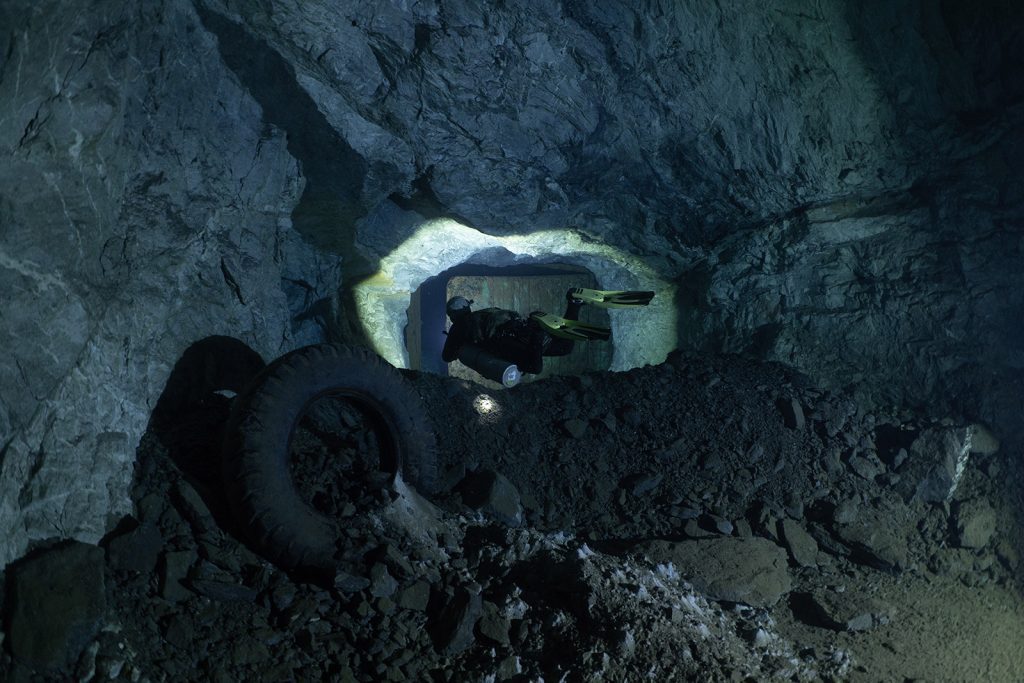
The Future of Thai Mine Diving
Discovering something this big and beautiful being hidden and forgotten for decades is the sole reason why we train so hard everyday. The fact that there might not be any blueprints for this mine just makes the adventure so much more appealing, and it becomes true exploration. Not knowing what lies around the next corner or when you might be at the end of the last corridor, and being the first one to visit the century-long history of the three generations of the Bhol mining family’s underground enterprise is well worth the elevated risk that comes with exploratory mine diving.
With such world-class diving possibilities, the surrounding natural caves, rivers, waterfalls, and hot springs, this place needs to be taken seriously. Were the caves to be carefully surveyed, the local community could welcome more adventurous visitors to the region–explorers who would enjoy Thailand’s longest underground tunnels as well as the warm and crystal clear flooded sections of this beautiful monster of a mine.
We have decided to keep the exact coordinates amongst just a few of us to hopefully avoid less-experienced adventure seekers from rushing in without proper training. Meanwhile, we will try to negotiate the terms of the use, and survey the site properly using the 3D photogrammetry method as our main tool to understand the magnitude of this complex.
Until today, we have managed to take various water and dust samples from different locations, and so far we haven’t found any elevated traces of lead or any other toxins. The local community has given us exclusive permission to keep exploring deeper into the mines, and the next big push is scheduled at the end of April 2023. This time, we will have to start mixing helium in the blend because it is now obvious that the mine goes way past air diluent depths. Another tool I will add to my artillery next time is the helmet. We had a friendly reminder from a dive we did with our Thai team Por Parasu Komaradat and Norrased Palasing where we experienced a couple of small collapses in the side passages and that put the whole team on alert. I plan to also consider if parts of the mine are too fragile to dive, especially on open circuit. As safety is our number one goal, these mines obviously will only be open for divers with proper (mine diver) training and site introduction.
So far, all the interviews with the old miners haven’t brought us any credible data, as they all recall things slightly differently. We have located a fourth mine in the same region, but no permission for exploration has been granted yet because the locals are too worried about us getting hurt by the wild elephants living in the area. We believe that there will be real exploration and new projects around these mines for years to come and would like to encourage CCR exploration-minded teams or individuals to reach out and get involved in the upcoming series of expeditions.
All and all, a new era of overhead environment diving in Thailand has begun, and we are extremely excited to seewhere this all will lead and how many more diveable mines there will be once the word is out.
This series of expeditions is supported by XDEEP Exploration Support Program, SEAL dry suits and Big Blue Dive Lights.
Dive Deeper
Great Mines!
InDEPTH: Out of the Depths: The Story of British Mine Diving by Jon Glanfield
InDEPTH:They Discovered an 11,000-year-old Submerged Ochre Mine by John Kendall
InDEPTH: I See A Darkness: A Descent Into Germany’s Felicitas Mine by Andrea Murdock Alpini
inDEPTH: Mine Over Monitor: Iconic dive sites with a shared history by Edd Stockdale

Mikko Paasi is a passionate explorer, ccr cave/mine Instructor Trainer and an underwater camera operator. His soon 30 year long professional diving career started at Ojamo mine, Finland, in the 90’s. Today he runs his dive center, Koh Tao Divers, in Thailand and conducts constantly new diving related projects and expeditions through his foundation called Bottomline Projects. Mikko has been involved in multiple documentaries and movies both, behind and in front of the camera, latest being a film called Ghost Ships which is now premiering in the Berlin Film Festival. He played a key role in the Thai Cave Rescue 2018 from where the King of Thailand awarded him with a 1st class Knight Grand Cross.





















